|
JULY
2010
�����������������������������������������������������������������������������������������������������������������������������������������������������
31st July 2010 - New research
MIRAPEX ER CLINICAL TRIAL RESULTS
Movement Disorders [2010] Jul 28 [Epub ahead of
print] (Hauser RA, Schapira AH, Rascol O, Barone P, Mizuno Y, Salin L, Haaksma
M, Juhel N, Poewe W.)
Complete abstract
Movement Disorders [2010]
Jul 28 [Epub ahead of print] (Rascol O, Barone P, Hauser RA, Mizuno Y, Poewe W,
Schapira AH, Salin L, Sohr M, Debieuvre C)
Complete abstract
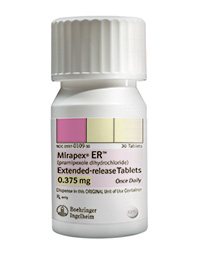 The
objective of this study was to evaluate the efficacy and safety of pramipexole
extended release (ER) administered once daily in early Parkinson's Disease.
Pramipexole extended release (ER) is marketed as
Mirapex ER. Pramipexole immediate release (IR) is administered three
times daily. Pramipexole ER was proven to be effective. The level of efficacy
was almost identical to that of immediate release Pramipexole, demonstrating
that there was no loss of activity when changing over
from the immediate release version of Pramipexole. Adverse events more common
with Pramipexole ER than placebo included somnolence, nausea, constipation, and
fatigue. The
objective of this study was to evaluate the efficacy and safety of pramipexole
extended release (ER) administered once daily in early Parkinson's Disease.
Pramipexole extended release (ER) is marketed as
Mirapex ER. Pramipexole immediate release (IR) is administered three
times daily. Pramipexole ER was proven to be effective. The level of efficacy
was almost identical to that of immediate release Pramipexole, demonstrating
that there was no loss of activity when changing over
from the immediate release version of Pramipexole. Adverse events more common
with Pramipexole ER than placebo included somnolence, nausea, constipation, and
fatigue.
In a separate study,
the feasibility was
assessed, in early Parkinson's Disease, of an overnight switch from
immediate-release (IR) pramipexole to a once-daily extended-release (ER)
pramipexole. Over 80% of people successfully changed over to the extended
release version of pramipexole after 4 weeks, and around 85% successfully
changed over to the extended release version of pramipexole after 9 weeks. So
changing over to the extended release version is not quick and always
successful. In order to refer to this article on its own
click here.
�
29th July 2010 - New research
NEBICAPONE - A NEW COMT INHIBITOR FOR PARKINSON'S DISEASE
CNS Neuroscience &
Therapeutics [2010] Jul 23 [Epub ahead of print] (Ferreira JJ, Rascol O, Poewe
W, Sampaio C, Rocha JF, Nunes T, Almeida L, Soares-da-Silva P)
Complete abstract
Nebicapone,
is a new COMT inhibitor undergoing clinical trials for the treatment of motor fluctuations in Parkinson's
Disease. COMT inhibitors
help to prolong the effect of L-dopa. The two COMT inhibitors that have already
being used to treat Parkinson's Disease are
Tolcapone
(Tasmar), and
Entacapone (Comtan), which is also marketed as
Stalevo
in a combination with L-dopa and carbidopa.
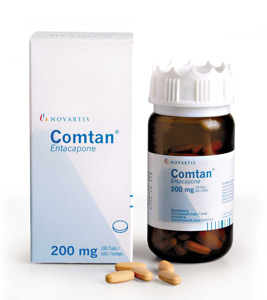 A
clinical trial compared the use of
Nebicapone (50 mg, 100 mg,
150 mg) with Entacapone (200 mg) or placebo administered with L-dopa/carbidopa
(Sinemet) or levodopa/benserazide (Madopar). The 150mg dosage of Nebicapone were
found to be more effective than the existing COMT inhibitors, by decreasing the
off time by 81 minutes in comparison to Entacapone, and by 106 minutes in comparison
to the placebo. The 50mg and 100mg dosages of Nebicapone failed to have a
significant effect in reducing off time. Treatment-emergent adverse events were
reported by 32% to 49% of patients in any treatment group, with no observed dose
relationship in the Nebicapone groups. Liver transaminases were elevated in 8%
of the 150mg Nebicapone group.
In order to refer to this article on its own
click here. A
clinical trial compared the use of
Nebicapone (50 mg, 100 mg,
150 mg) with Entacapone (200 mg) or placebo administered with L-dopa/carbidopa
(Sinemet) or levodopa/benserazide (Madopar). The 150mg dosage of Nebicapone were
found to be more effective than the existing COMT inhibitors, by decreasing the
off time by 81 minutes in comparison to Entacapone, and by 106 minutes in comparison
to the placebo. The 50mg and 100mg dosages of Nebicapone failed to have a
significant effect in reducing off time. Treatment-emergent adverse events were
reported by 32% to 49% of patients in any treatment group, with no observed dose
relationship in the Nebicapone groups. Liver transaminases were elevated in 8%
of the 150mg Nebicapone group.
In order to refer to this article on its own
click here.
�
28th
July 2010 - New book
THE BOOK OF EXERCISE AND YOGA FOR
THOSE WITH PARKINSON'S DISEASE
Lori A.Newell
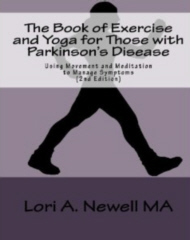 Publisher's
description : This book covers a wide range of movement therapies such as range
of motion exercises, low to no-impact aerobics, strength training, yoga, and
T'ai Chi. It is unique in that it covers a wide range of techniques, which are
specifically geared to, and have been proven helpful for, those with Parkinson's
disease. The exercises are all explained in detail utilizing safe body mechanics
and are illustrated in standing, standing holding onto a chair, and seated
variations to accommodate a wide variety of abilities. This complete wellness
program goes beyond the traditional exercise book offering information on home
safety, fall prevention, activities of daily living, and body mechanics.�
Click here for more details.
For
more books concerning Parkinson's Disease go to
Parkinson's Disease Books. Publisher's
description : This book covers a wide range of movement therapies such as range
of motion exercises, low to no-impact aerobics, strength training, yoga, and
T'ai Chi. It is unique in that it covers a wide range of techniques, which are
specifically geared to, and have been proven helpful for, those with Parkinson's
disease. The exercises are all explained in detail utilizing safe body mechanics
and are illustrated in standing, standing holding onto a chair, and seated
variations to accommodate a wide variety of abilities. This complete wellness
program goes beyond the traditional exercise book offering information on home
safety, fall prevention, activities of daily living, and body mechanics.�
Click here for more details.
For
more books concerning Parkinson's Disease go to
Parkinson's Disease Books.
�
26th July 2010 - New review
THE EFFECTS OF COENZYME Q10 ON
PARKINSON'S DISEASE
The mitochondria is the
part of the cells that produces energy. The first step in producing energy in
the mitochondria is Complex I (NADH : ubiquinone oxidoreductase). In people with
Parkinson's Disease, Complex I is reduced in activity in the substantia nigra,
which is the part of the brain primarily affected in Parkinson's Disease.
Complex I needs Coenzyme Q10 in order to function properly
[1]. However, energy production has no direct
effect on increasing dopamine formation� It has been claimed that Coenzyme
Q10 is a potent antioxidant that can partially recover the function of
dopaminergic neurons (the cells involved in Parkinson's Disease).
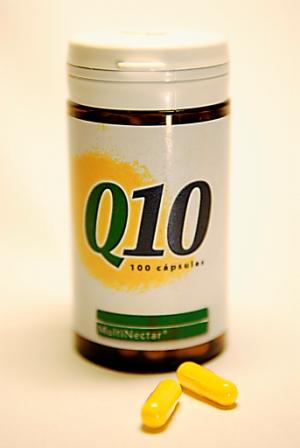 Coenzyme
Q10 was found to be completely ineffective in Parkinson's Disease in daily doses
of 200mg
[2], 300mg
[3], 400mg
[4], 600mg
[4], and 800mg
[4]. Only one Coenzyme Q10 study has ever shown
any improvement in Parkinson's Disease, using 360mg, but the effects were mild
and were only assessed for four weeks
[5]. Daily doses of 300mg, 600mg and 1200 mg of
Coenzyme Q10 failed to improve the symptoms of Parkinson's Disease, but reduced
the rate of deterioration
[6]. Coenzyme Q10 was safe to use in doses of
1200mg
[6]
[7], 1800mg
[7], 2400
[7], and 3000 mg
[7]. Plasma levels of Coenzyme Q10 did not
increase in doses above 2400mg
[7].
In order to refer to this article on its own
click here. Coenzyme
Q10 was found to be completely ineffective in Parkinson's Disease in daily doses
of 200mg
[2], 300mg
[3], 400mg
[4], 600mg
[4], and 800mg
[4]. Only one Coenzyme Q10 study has ever shown
any improvement in Parkinson's Disease, using 360mg, but the effects were mild
and were only assessed for four weeks
[5]. Daily doses of 300mg, 600mg and 1200 mg of
Coenzyme Q10 failed to improve the symptoms of Parkinson's Disease, but reduced
the rate of deterioration
[6]. Coenzyme Q10 was safe to use in doses of
1200mg
[6]
[7], 1800mg
[7], 2400
[7], and 3000 mg
[7]. Plasma levels of Coenzyme Q10 did not
increase in doses above 2400mg
[7].
In order to refer to this article on its own
click here.
�
21st July 2010 - New review
CABERGOLINE - A REVIEW OF THE DOPAMINE
AGONIST
Cabergoline is also
known by the brand names Dostinex and Cabaser. Cabergoline is a dopamine agonist
that primarily stimulates the D2 receptor activity and has a very long half-life
[1].
Besides being used for the treatment of Parkinson's Disease, cabergoline is also
used for the treatment of hyperprolactinemia, and also exerts anti-depressant effects
[2]. For more information got to
Dostinex and
Cabaser.
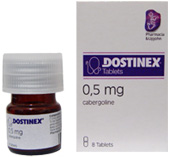 When
cabergoline was compared to the use of L-dopa for Parkinson's Disease : motor complications, such as
dyskinesia occurred less frequently
[3], symptoms overall were worse
[4], some symptom scores apart from motor
disability were better
[3],
off time was reduced
[5]
[6], there were greater side effects
[3]
[4]
[7], including nausea, vomiting, dyspepsia,
gastritis, dizziness, postural hypotension, and peripheral oedema
[8]. When cabergoline was added to the use of
L-dopa : symptoms improved
[9]
[10]
[11]
[12]
[13]
[14] but not by much
[13],
there was a small reduction in off time
[3]
[12]
[13]
[15]
[16], L-dopa dose could be reduced
[3]
[5],
and side effects increased
[10]
[11]
[13].
Cabergoline was found to be slightly better or similar than the use of
bromocriptine
[15]
[17]. When
cabergoline was compared to the use of L-dopa for Parkinson's Disease : motor complications, such as
dyskinesia occurred less frequently
[3], symptoms overall were worse
[4], some symptom scores apart from motor
disability were better
[3],
off time was reduced
[5]
[6], there were greater side effects
[3]
[4]
[7], including nausea, vomiting, dyspepsia,
gastritis, dizziness, postural hypotension, and peripheral oedema
[8]. When cabergoline was added to the use of
L-dopa : symptoms improved
[9]
[10]
[11]
[12]
[13]
[14] but not by much
[13],
there was a small reduction in off time
[3]
[12]
[13]
[15]
[16], L-dopa dose could be reduced
[3]
[5],
and side effects increased
[10]
[11]
[13].
Cabergoline was found to be slightly better or similar than the use of
bromocriptine
[15]
[17].
Cabergoline is associated with the risk of
valvular heart disease
[18], valvular regurgitation
[19]
[20]
[21]
[22]
[23]
[24], and
worsens contrast sensitivity
[25].
In order to refer to this article on its own
click here.
�
16th July 2010 - New research
THE
most troubling SYMPTOMS IN parkinson's diseasE
Movement Disorders [2010] May 14 [Epub ahead of print] (Politis
M, Wu K, Molloy S, G Bain P, Chaudhuri KR, Piccini P.)
Complete abstract
People with Parkinson's Disease typically experience a range of symptoms
over time, each of which will affect a particular individual to varying
degrees. However, patients' perceptions of troublesome symptoms often
differ from the clinician's view, and these discrepancies can hamper
effective management of Parkinson's Disease. In this study, people with
Parkinson's Disease were asked to rank their three most troublesome
symptoms. Patients were divided into early Parkinson's Disease (less than
6 years) and late Parkinson's Disease (longer than 6 years).
 In early
Parkinson's
Disease, the five most prevalent complaints ranked in descending order
were : slowness, tremor,
stiffness, pain, and then loss of smell or taste. In advanced Parkinson's
Disease the five most prevalent complaints ranked in descending order were
:� fluctuating response to medication (most commonly wearing�
off followed by dyskinesia), mood changes, drooling, sleep problems (most
commonly middle and late night insomnia followed by daytime sleepiness),
and then tremor. So as Parkinson's Disease progresses
the most troublesome issues change considerably. In order to refer to this
article on its own
click here. In early
Parkinson's
Disease, the five most prevalent complaints ranked in descending order
were : slowness, tremor,
stiffness, pain, and then loss of smell or taste. In advanced Parkinson's
Disease the five most prevalent complaints ranked in descending order were
:� fluctuating response to medication (most commonly wearing�
off followed by dyskinesia), mood changes, drooling, sleep problems (most
commonly middle and late night insomnia followed by daytime sleepiness),
and then tremor. So as Parkinson's Disease progresses
the most troublesome issues change considerably. In order to refer to this
article on its own
click here.
�
13th July 2010 - New research
vitamin d deficiency linked to parkinson's diseasE
Archives of Neurology [2010] 67 (7) : 808-811 (Knekt
P, Kilkkinen A, Rissanen H, Marniemi J, S��ksj�rvi K, Heli�vaara M.)
Complete abstract
It has been widely reported that low vitamin
D increases the likelihood of Parkinson's Disease, such as in the
following
News report.
However, of the two studies referred to, one of them does not concern
Parkinson's Disease at all. In the other study, those people with
Parkinson's Disease
who had the lowest amounts of
vitamin D were three times more likely to develop Parkinson's than those
with the highest amounts of vitamin D. In a previous study assessing the
same question, 55% of people
with Parkinson's
Disease had insufficient vitamin D, in comparison to 36%
of� healthy controls, which statistically, is not very significant. For the details go to the
Complete abstract.
The
researchers claim that this data supports a possible role of vitamin D
insufficiency in causing Parkinson's Disease.
 However, Vitamin D has no role at all in the formation of
dopamine, the substance whose deficiency causes Parkinson's Disease. For
more
information go to the
Biochemistry of Parkinson's Disease. In severe cases of Vitamin
D deficiency, there is no known relationship with Parkinson's
Disease as there certainly would be if Vitamin D deficiency could cause it. Sunlight is a
primary source of Vitamin D. So the link between Vitamin D and
Parkinson's Disease may be due to some people with Parkinson's Disease who
have mobility problems being exposed to less sunlight, and so having lower vitamin D levels.
In order to refer to this
article on its own
click here. However, Vitamin D has no role at all in the formation of
dopamine, the substance whose deficiency causes Parkinson's Disease. For
more
information go to the
Biochemistry of Parkinson's Disease. In severe cases of Vitamin
D deficiency, there is no known relationship with Parkinson's
Disease as there certainly would be if Vitamin D deficiency could cause it. Sunlight is a
primary source of Vitamin D. So the link between Vitamin D and
Parkinson's Disease may be due to some people with Parkinson's Disease who
have mobility problems being exposed to less sunlight, and so having lower vitamin D levels.
In order to refer to this
article on its own
click here.
�
11th July 2010 - New research
ADDING DRUGS TO
L-DOPA IN PARKINSON'S DISEASE
Cochrane Database Systematic Reviews [2010] 7 :
CD007166 (Stowe R, Ives N, Clarke CE, Deane K; van Hilten, Wheatley K, Gray R,
Handley K, Furmston A.)
Complete abstract
At some point, medical practitioners usually add an additional drug
to L-dopa when treating Parkinson's Disease from one of three other types of
Parkinson's Disease drugs : dopamine agonists, COMT inhibitors (tolcapone,
entacapone), or MAO inhibitors (selegiline, rasagiline). However, it remained
unclear as to the whether one class of drug is more effective than the other.�
The three types of drug were compared, using all of the relevant clinical
trials.
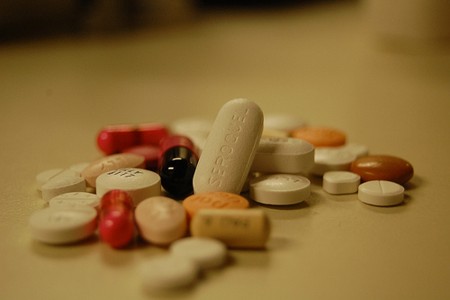 Adding another drug to L-dopa reduced off-time by
only an hour, reduced the L-dopa dosage by about 55mg per day, and slightly
improved symptom scores. A lot of side effects increased :
nausea,
dyskinesia,
constipation, dizziness, dry mouth, hallucinations, hypotension, insomnia, somnolence and vomiting. Comparisons of the three drug types suggested
that dopamine agonists were more effective in reducing off-time, reducing
L-dopa dosage, and improving symptom scores.� Incidence of side
effects was least with MAO inhibitors, but only marginally better than dopamine
agonists.
In order to refer to this
article on its own
click here. Adding another drug to L-dopa reduced off-time by
only an hour, reduced the L-dopa dosage by about 55mg per day, and slightly
improved symptom scores. A lot of side effects increased :
nausea,
dyskinesia,
constipation, dizziness, dry mouth, hallucinations, hypotension, insomnia, somnolence and vomiting. Comparisons of the three drug types suggested
that dopamine agonists were more effective in reducing off-time, reducing
L-dopa dosage, and improving symptom scores.� Incidence of side
effects was least with MAO inhibitors, but only marginally better than dopamine
agonists.
In order to refer to this
article on its own
click here.
�
�������������������������������������������������������������������������������������������������������������������������������������������������� �9th July 2010 - New research
GENE THERAPY FOR PARKINSON'S
DISEASE
Molecular Therapy [2010] Jul 6 [Epub ahead of
print] (Muramatsu SI, Fujimoto KI, Kato S, Mizukami H, Asari S, Ikeguchi K,
Kawakami T, Urabe M, Kume A, Sato T, Watanabe E, Ozawa K, Nakano I.)
Complete abstract
The primary fault in Parkinson's Disease is the
inability to produce sufficient dopamine via dopamine producing enzymes in the brain. Gene transfer of dopamine
producing enzymes into the brain has led to recovery in animal
models of Parkinson's Disease.
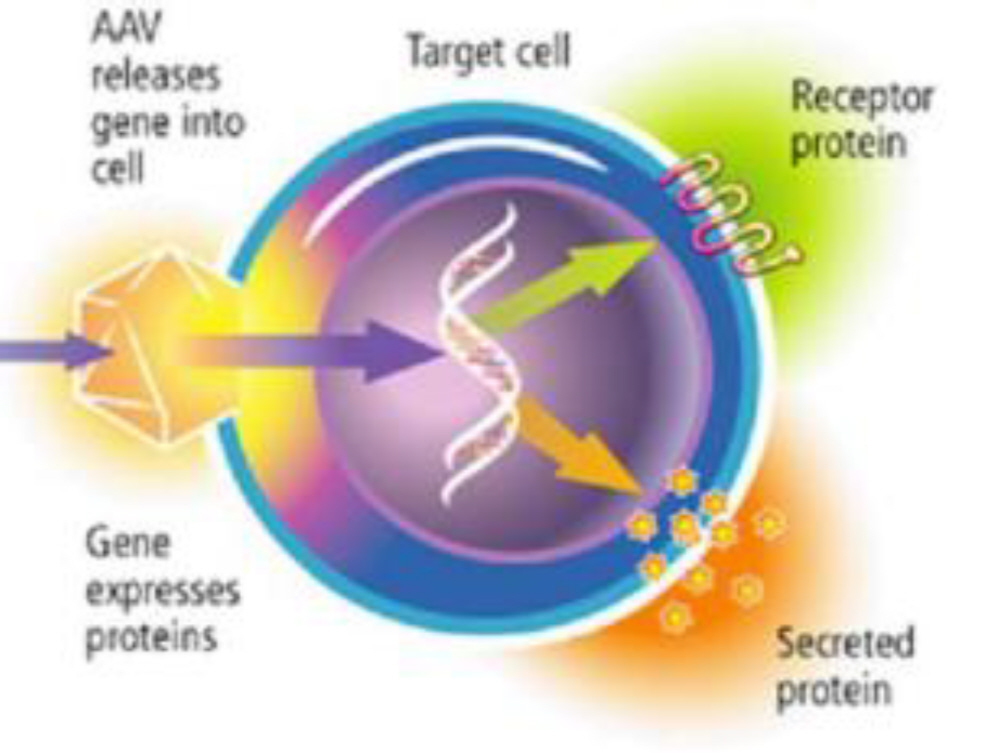 So researchers
evaluated the safety, tolerability, and potential efficacy of adeno-associated virus (AAV) gene delivery of the enzyme
that produces dopamine into the brain of people with Parkinson's Disease. Six
Parkinson's Disease patients were evaluated at the start and after six months,
using a variety of measures. The procedure was well tolerated. Six months after
surgery, motor functions in the off-medication state improved by an average of
46% based on the UPDRS symptom questionnaire. Assessment using scanning saw a
56% improvement, which persisted up to 96 weeks.
In order to refer to this
article on its own
click here. So researchers
evaluated the safety, tolerability, and potential efficacy of adeno-associated virus (AAV) gene delivery of the enzyme
that produces dopamine into the brain of people with Parkinson's Disease. Six
Parkinson's Disease patients were evaluated at the start and after six months,
using a variety of measures. The procedure was well tolerated. Six months after
surgery, motor functions in the off-medication state improved by an average of
46% based on the UPDRS symptom questionnaire. Assessment using scanning saw a
56% improvement, which persisted up to 96 weeks.
In order to refer to this
article on its own
click here.
�
5th July 2010 - New book
I WILL GO ON : LIVING WITH A MOVEMENT
DISORDER
Dr Daniel Brooks
 Publisher's
description : Daniel Brooks was a 50-year-old husband, father and district-level
administrator in a public school system, when he first noticed pronounced
tremors, speech difficulties and walking problems developing. In this book,
Daniel chronicles his life with a Parkinson�s Plus syndrome and explains how he
dealt with the neurological decline that resulted. Read a user-friendly,
patient's explanation of the defining symptoms of these atypical Parkinsonism
disorders and find out how this neuro-degenerative disease progressed in Dan�s
case. He writes a compelling and inspirational story of how he maintained his
faith in God, while facing life with a movement disorder.
Click here for more details.
For
more books concerning Parkinson's Disease go to
Parkinson's Disease Books.
For Daniel's blog, go to
We Will Go On. Publisher's
description : Daniel Brooks was a 50-year-old husband, father and district-level
administrator in a public school system, when he first noticed pronounced
tremors, speech difficulties and walking problems developing. In this book,
Daniel chronicles his life with a Parkinson�s Plus syndrome and explains how he
dealt with the neurological decline that resulted. Read a user-friendly,
patient's explanation of the defining symptoms of these atypical Parkinsonism
disorders and find out how this neuro-degenerative disease progressed in Dan�s
case. He writes a compelling and inspirational story of how he maintained his
faith in God, while facing life with a movement disorder.
Click here for more details.
For
more books concerning Parkinson's Disease go to
Parkinson's Disease Books.
For Daniel's blog, go to
We Will Go On.
�
3rd July 2010 - New research
ENTACAPONE CLINICAL TRIAL
RESULTS
Annals of Neurology [2010] 68 (1) : 18-27 (Stocchi
F, Rascol O, Kieburtz K, Poewe W, Jankovic J, Tolosa E, Barone P, Lang AE,
Olanow CW.)�
Complete abstract
Entacapone is a COMT inhibitor, which is able to
slow down the breakdown of L-dopa. It is marketed for Parkinson's Disease on its
own as Comtan, and also as Stalevo in combination with L-dopa and carbidopa, the
same two substances in Sinemet. Adding Entacapone to the equivalent of Sinemet was
considered to be potentially advantageous over Sinemet in the treatment of Parkinson's Disease.
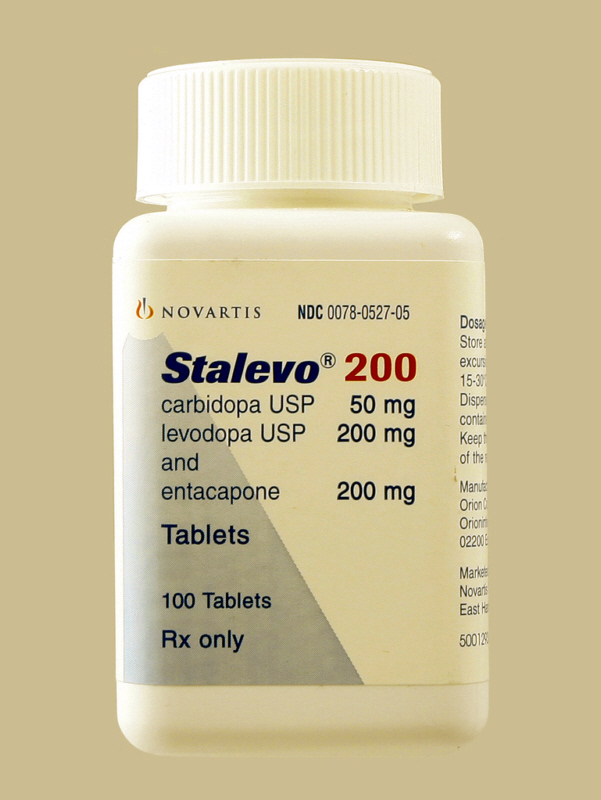 However, in
recent clinical trials, the time taken for the effectiveness to wear off
between the two methods was not actually significantly different. There was a
tendency that favoured those taking Entacapone. However, the Entacapone group
received a higher dose equivalent. Adding Entacapone to the equivalent of
Sinemet was also found to speed up the onset of dyskinesia. This was especially
so in people that were also taking dopamine agonists. These results make the
claimed advantages of adding Entacapone to Sinemet questionable.
In order to refer to this
article on its own
click here. However, in
recent clinical trials, the time taken for the effectiveness to wear off
between the two methods was not actually significantly different. There was a
tendency that favoured those taking Entacapone. However, the Entacapone group
received a higher dose equivalent. Adding Entacapone to the equivalent of
Sinemet was also found to speed up the onset of dyskinesia. This was especially
so in people that were also taking dopamine agonists. These results make the
claimed advantages of adding Entacapone to Sinemet questionable.
In order to refer to this
article on its own
click here.
�
2nd July 2010 - New book
NO DOOR WIDE ENOUGH : 2000-2010, MY PARKINSON'S
DISEASE DECADE
Bill Schmalfeldt
 Publisher's
description : It was just about three weeks after his 45th birthday in 2000 when
Bill Schmalfeldt was diagnosed with Parkinson's disease. In 2007 while working
at a federal agency as a writer and podcaster, telling other people about the
importance of clinical trials, Bill heard about and volunteered for an
experimental brain surgery to determine whether or not "deep brain stimulation"
could be done on patients in the earlier stages of the disease. This is the
story of Bill's "Parkinson's Decade" from being diagnosed in 2000, to having the
surgery in 2007, through today. The story is told in a humorous, satirical,
almost jovial style considering the fact that Bill's motor skills and cognition
continue to degenerate.
Click here for more details.
For
more books concerning Parkinson's Disease go to
Parkinson's Disease Books. Publisher's
description : It was just about three weeks after his 45th birthday in 2000 when
Bill Schmalfeldt was diagnosed with Parkinson's disease. In 2007 while working
at a federal agency as a writer and podcaster, telling other people about the
importance of clinical trials, Bill heard about and volunteered for an
experimental brain surgery to determine whether or not "deep brain stimulation"
could be done on patients in the earlier stages of the disease. This is the
story of Bill's "Parkinson's Decade" from being diagnosed in 2000, to having the
surgery in 2007, through today. The story is told in a humorous, satirical,
almost jovial style considering the fact that Bill's motor skills and cognition
continue to degenerate.
Click here for more details.
For
more books concerning Parkinson's Disease go to
Parkinson's Disease Books.
��������������
��
|
.gif)
.gif)
 The
objective of this study was to evaluate the efficacy and safety of pramipexole
extended release (ER) administered once daily in early Parkinson's Disease.
Pramipexole extended release (ER) is marketed as
The
objective of this study was to evaluate the efficacy and safety of pramipexole
extended release (ER) administered once daily in early Parkinson's Disease.
Pramipexole extended release (ER) is marketed as
 A
clinical trial compared the use of
Nebicapone (50 mg, 100 mg,
150 mg) with Entacapone (200 mg) or placebo administered with L-dopa/carbidopa
(Sinemet) or levodopa/benserazide (Madopar). The 150mg dosage of Nebicapone were
found to be more effective than the existing COMT inhibitors, by decreasing the
off time by 81 minutes in comparison to Entacapone, and by 106 minutes in comparison
to the placebo. The 50mg and 100mg dosages of Nebicapone failed to have a
significant effect in reducing off time. Treatment-emergent adverse events were
reported by 32% to 49% of patients in any treatment group, with no observed dose
relationship in the Nebicapone groups. Liver transaminases were elevated in 8%
of the 150mg Nebicapone group.
In order to refer to this article on its own
A
clinical trial compared the use of
Nebicapone (50 mg, 100 mg,
150 mg) with Entacapone (200 mg) or placebo administered with L-dopa/carbidopa
(Sinemet) or levodopa/benserazide (Madopar). The 150mg dosage of Nebicapone were
found to be more effective than the existing COMT inhibitors, by decreasing the
off time by 81 minutes in comparison to Entacapone, and by 106 minutes in comparison
to the placebo. The 50mg and 100mg dosages of Nebicapone failed to have a
significant effect in reducing off time. Treatment-emergent adverse events were
reported by 32% to 49% of patients in any treatment group, with no observed dose
relationship in the Nebicapone groups. Liver transaminases were elevated in 8%
of the 150mg Nebicapone group.
In order to refer to this article on its own
 Publisher's
description : This book covers a wide range of movement therapies such as range
of motion exercises, low to no-impact aerobics, strength training, yoga, and
T'ai Chi. It is unique in that it covers a wide range of techniques, which are
specifically geared to, and have been proven helpful for, those with Parkinson's
disease. The exercises are all explained in detail utilizing safe body mechanics
and are illustrated in standing, standing holding onto a chair, and seated
variations to accommodate a wide variety of abilities. This complete wellness
program goes beyond the traditional exercise book offering information on home
safety, fall prevention, activities of daily living, and body mechanics.�
Publisher's
description : This book covers a wide range of movement therapies such as range
of motion exercises, low to no-impact aerobics, strength training, yoga, and
T'ai Chi. It is unique in that it covers a wide range of techniques, which are
specifically geared to, and have been proven helpful for, those with Parkinson's
disease. The exercises are all explained in detail utilizing safe body mechanics
and are illustrated in standing, standing holding onto a chair, and seated
variations to accommodate a wide variety of abilities. This complete wellness
program goes beyond the traditional exercise book offering information on home
safety, fall prevention, activities of daily living, and body mechanics.�
 Coenzyme
Q10 was found to be completely ineffective in Parkinson's Disease in daily doses
of 200mg
Coenzyme
Q10 was found to be completely ineffective in Parkinson's Disease in daily doses
of 200mg
 When
cabergoline was compared to the use of L-dopa for Parkinson's Disease : motor complications, such as
dyskinesia occurred less frequently
When
cabergoline was compared to the use of L-dopa for Parkinson's Disease : motor complications, such as
dyskinesia occurred less frequently
 In early
Parkinson's
Disease, the five most prevalent complaints ranked in descending order
were : slowness, tremor,
stiffness, pain, and then loss of smell or taste. In advanced Parkinson's
Disease the five most prevalent complaints ranked in descending order were
:� fluctuating response to medication (most commonly wearing�
off followed by dyskinesia), mood changes, drooling, sleep problems (most
commonly middle and late night insomnia followed by daytime sleepiness),
and then tremor. So as Parkinson's Disease progresses
the most troublesome issues change considerably. In order to refer to this
article on its own
In early
Parkinson's
Disease, the five most prevalent complaints ranked in descending order
were : slowness, tremor,
stiffness, pain, and then loss of smell or taste. In advanced Parkinson's
Disease the five most prevalent complaints ranked in descending order were
:� fluctuating response to medication (most commonly wearing�
off followed by dyskinesia), mood changes, drooling, sleep problems (most
commonly middle and late night insomnia followed by daytime sleepiness),
and then tremor. So as Parkinson's Disease progresses
the most troublesome issues change considerably. In order to refer to this
article on its own
 However, Vitamin D has no role at all in the formation of
dopamine, the substance whose deficiency causes Parkinson's Disease. For
more
information go to the
However, Vitamin D has no role at all in the formation of
dopamine, the substance whose deficiency causes Parkinson's Disease. For
more
information go to the
 Adding another drug to L-dopa reduced off-time by
only an hour, reduced the L-dopa dosage by about 55mg per day, and slightly
improved symptom scores. A lot of side effects increased :
nausea,
dyskinesia,
constipation, dizziness, dry mouth, hallucinations, hypotension, insomnia, somnolence and vomiting. Comparisons of the three drug types suggested
that dopamine agonists were more effective in reducing off-time, reducing
L-dopa dosage, and improving symptom scores.� Incidence of side
effects was least with MAO inhibitors, but only marginally better than dopamine
agonists.
Adding another drug to L-dopa reduced off-time by
only an hour, reduced the L-dopa dosage by about 55mg per day, and slightly
improved symptom scores. A lot of side effects increased :
nausea,
dyskinesia,
constipation, dizziness, dry mouth, hallucinations, hypotension, insomnia, somnolence and vomiting. Comparisons of the three drug types suggested
that dopamine agonists were more effective in reducing off-time, reducing
L-dopa dosage, and improving symptom scores.� Incidence of side
effects was least with MAO inhibitors, but only marginally better than dopamine
agonists.
 So researchers
evaluated the safety, tolerability, and potential efficacy of adeno-associated virus (AAV) gene delivery of the enzyme
that produces dopamine into the brain of people with Parkinson's Disease. Six
Parkinson's Disease patients were evaluated at the start and after six months,
using a variety of measures. The procedure was well tolerated. Six months after
surgery, motor functions in the off-medication state improved by an average of
46% based on the UPDRS symptom questionnaire. Assessment using scanning saw a
56% improvement, which persisted up to 96 weeks.
So researchers
evaluated the safety, tolerability, and potential efficacy of adeno-associated virus (AAV) gene delivery of the enzyme
that produces dopamine into the brain of people with Parkinson's Disease. Six
Parkinson's Disease patients were evaluated at the start and after six months,
using a variety of measures. The procedure was well tolerated. Six months after
surgery, motor functions in the off-medication state improved by an average of
46% based on the UPDRS symptom questionnaire. Assessment using scanning saw a
56% improvement, which persisted up to 96 weeks.  Publisher's
description : Daniel Brooks was a 50-year-old husband, father and district-level
administrator in a public school system, when he first noticed pronounced
tremors, speech difficulties and walking problems developing. In this book,
Daniel chronicles his life with a Parkinson�s Plus syndrome and explains how he
dealt with the neurological decline that resulted. Read a user-friendly,
patient's explanation of the defining symptoms of these atypical Parkinsonism
disorders and find out how this neuro-degenerative disease progressed in Dan�s
case. He writes a compelling and inspirational story of how he maintained his
faith in God, while facing life with a movement disorder.
Publisher's
description : Daniel Brooks was a 50-year-old husband, father and district-level
administrator in a public school system, when he first noticed pronounced
tremors, speech difficulties and walking problems developing. In this book,
Daniel chronicles his life with a Parkinson�s Plus syndrome and explains how he
dealt with the neurological decline that resulted. Read a user-friendly,
patient's explanation of the defining symptoms of these atypical Parkinsonism
disorders and find out how this neuro-degenerative disease progressed in Dan�s
case. He writes a compelling and inspirational story of how he maintained his
faith in God, while facing life with a movement disorder.
 However, in
recent clinical trials, the time taken for the effectiveness to wear off
between the two methods was not actually significantly different. There was a
tendency that favoured those taking Entacapone. However, the Entacapone group
received a higher dose equivalent. Adding Entacapone to the equivalent of
Sinemet was also found to speed up the onset of dyskinesia. This was especially
so in people that were also taking dopamine agonists. These results make the
claimed advantages of adding Entacapone to Sinemet questionable.
However, in
recent clinical trials, the time taken for the effectiveness to wear off
between the two methods was not actually significantly different. There was a
tendency that favoured those taking Entacapone. However, the Entacapone group
received a higher dose equivalent. Adding Entacapone to the equivalent of
Sinemet was also found to speed up the onset of dyskinesia. This was especially
so in people that were also taking dopamine agonists. These results make the
claimed advantages of adding Entacapone to Sinemet questionable.  Publisher's
description : It was just about three weeks after his 45th birthday in 2000 when
Bill Schmalfeldt was diagnosed with Parkinson's disease. In 2007 while working
at a federal agency as a writer and podcaster, telling other people about the
importance of clinical trials, Bill heard about and volunteered for an
experimental brain surgery to determine whether or not "deep brain stimulation"
could be done on patients in the earlier stages of the disease. This is the
story of Bill's "Parkinson's Decade" from being diagnosed in 2000, to having the
surgery in 2007, through today. The story is told in a humorous, satirical,
almost jovial style considering the fact that Bill's motor skills and cognition
continue to degenerate.
Publisher's
description : It was just about three weeks after his 45th birthday in 2000 when
Bill Schmalfeldt was diagnosed with Parkinson's disease. In 2007 while working
at a federal agency as a writer and podcaster, telling other people about the
importance of clinical trials, Bill heard about and volunteered for an
experimental brain surgery to determine whether or not "deep brain stimulation"
could be done on patients in the earlier stages of the disease. This is the
story of Bill's "Parkinson's Decade" from being diagnosed in 2000, to having the
surgery in 2007, through today. The story is told in a humorous, satirical,
almost jovial style considering the fact that Bill's motor skills and cognition
continue to degenerate.